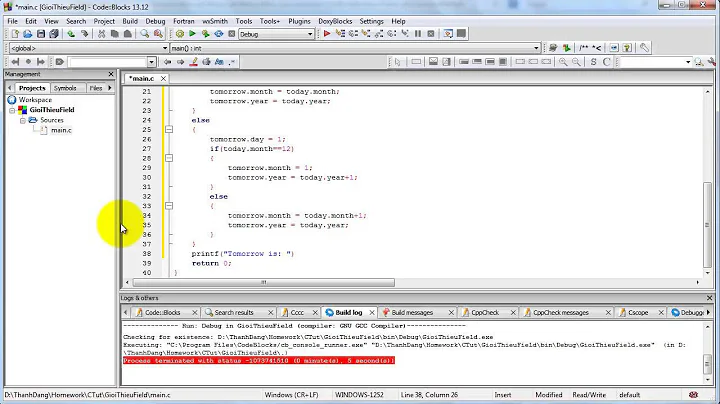Packed bit fields in c structures - GCC
Solution 1
Your structures are not "exactly the same". Your first one has three consecutive bit-fields, the second has one bit-field, an (non bit-field) int, and then a second bit-field.
This is significant: consecutive (non-zero width) bit-fields are merged into a single memory location, while a bit-field followed by a non-bit-field are distinct memory locations.
Your first structure has a single memory location, your second has three. You can take the address of the b member in your second struct, not in your first. Accesses to the b member don't race with accesses the a or c in your second struct, but they do in your first.
Having a non-bit-field (or a zero-length bit-field) right after a bit-field member "closes" it in a sense, what follows will be a different/independent memory location/object. The compiler cannot "pack" your b member inside the bit-field like it does in the first struct.
Solution 2
struct t1 // 6 bytes
{
int a:12; // 0:11
int b:32; // 12:43
int c:4; // 44:47
}__attribute__((packed));
struct t1 // 7 bytes
{
int a:12; // 0:11
int b; // 16:47
int c:4; // 48:51
}__attribute__((packed));
The regular int b must be aligned to a byte boundary. So there is padding before it. If you put c right next to a this padding will no longer be necessary. You should probably do this, as accessing non-byte-aligned integers like int b:32 is slow.
Related videos on Youtube
Danny Cohen
Updated on July 09, 2022Comments
-
 Danny Cohen almost 2 years
Danny Cohen almost 2 yearsI am working with structs in c on linux. I started using bit fields and the "packed" attribute and I came across a wierd behavior:
struct __attribute__((packed)) { int a:12; int b:32; int c:4; } t1; struct __attribute__((packed)) { int a:12; int b; int c:4; }t2; void main() { printf("%d\n",sizeof(t1)); //output - 6 printf("%d\n",sizeof(t2)); //output - 7 }How come both structures - that are exactly the same - take diffrent number of bytes?
-
Kerrek SB over 9 yearsBecause
t2::bis guaranteed to be a distinct memory location? Think of data races. -
 phuclv almost 3 years
phuclv almost 3 years
-
-
 Alexis almost 3 years
Alexis almost 3 yearsas accessing non-byte-aligned integers like int b:32 is slowsource? define slow. Doesn't it just shift and mask the memory value? -
 John Zwinck almost 3 yearsIt depends, but it will never be as fast as byte alignment. How slow (or even how we define slow) depends on the application, the compiler, etc.
John Zwinck almost 3 yearsIt depends, but it will never be as fast as byte alignment. How slow (or even how we define slow) depends on the application, the compiler, etc. -
 Alexis almost 3 yearsUnderstood, my guess is it's just a matter of fast shift+mask.
Alexis almost 3 yearsUnderstood, my guess is it's just a matter of fast shift+mask. -
 Matthew M. almost 2 yearsIt may just 'shift+mask' if the entire value fits into a single register. But there's a lot of maybes. Maybe it doesn't fit into a single register (platform-dependent) so it's 2 shifts, 2 masks, and an or between 2 registers. Maybe this structure is involved in an operation that could've been vectorized before but can't now (or can be but w/ unaligned loads). Lots of maybes.
Matthew M. almost 2 yearsIt may just 'shift+mask' if the entire value fits into a single register. But there's a lot of maybes. Maybe it doesn't fit into a single register (platform-dependent) so it's 2 shifts, 2 masks, and an or between 2 registers. Maybe this structure is involved in an operation that could've been vectorized before but can't now (or can be but w/ unaligned loads). Lots of maybes.







